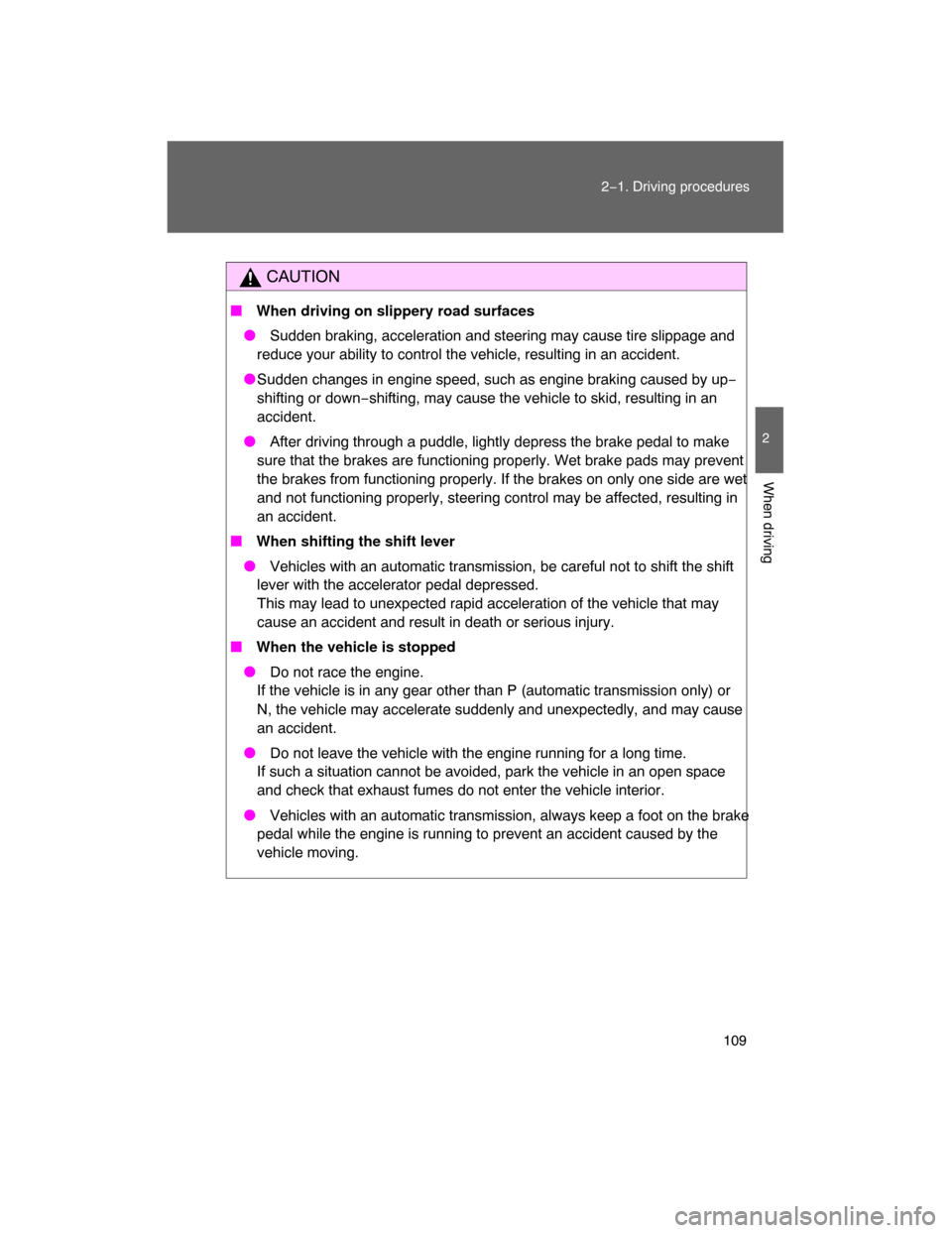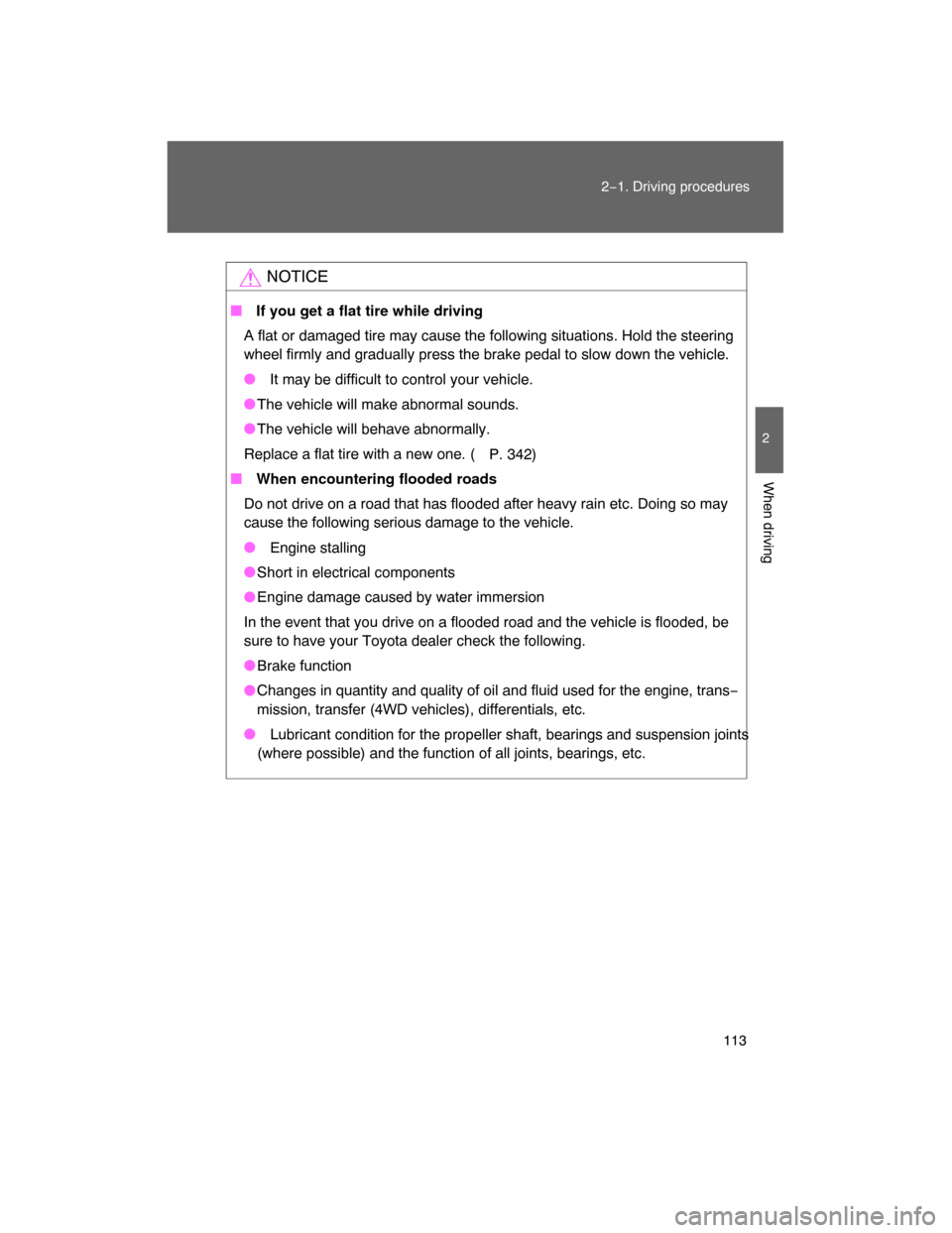Page 107 of 400

109
2−1. Driving procedures
2
When driving
CAUTION
� When driving on slippery road surfaces
� Sudden braking, acceleration and steering may cause tire slippage and
reduce your ability to control the vehicle, resulting in an accident.
�Sudden changes in engine speed, such as engine braking caused by up−
shifting or down−shifting, may cause the vehicle to skid, resulting in an
accident.
� After driving through a puddle, lightly depress the brake pedal to make
sure that the brakes are functioning properly. Wet brake pads may prevent
the brakes from functioning properly. If the brakes on only one side are wet
and not functioning properly, steering control may be affected, resulting in
an accident.
� When shifting the shift lever
� Vehicles with an automatic transmission, be careful not to shift the shift
lever with the accelerator pedal depressed.
This may lead to unexpected rapid acceleration of the vehicle that may
cause an accident and result in death or serious injury.
� When the vehicle is stopped
� Do not race the engine.
If the vehicle is in any gear other than P (automatic transmission only) or
N, the vehicle may accelerate suddenly and unexpectedly, and may cause
an accident.
� Do not leave the vehicle with the engine running for a long time.
If such a situation cannot be avoided, park the vehicle in an open space
and check that exhaust fumes do not enter the vehicle interior.
� Vehicles with an automatic transmission, always keep a foot on the brake
pedal while the engine is running to prevent an accident caused by the
vehicle moving.
Page 110 of 400

112 2−1. Driving procedures
NOTICE
� When driving the vehicle
Vehicles with a manual transmission
�Do not rest your foot on the clutch pedal while driving.
Doing so may cause clutch trouble.
� Do not use any gears other than the first gear when starting off and mov−
ing forward.
Doing so may damage the clutch.
� Do not use the clutch to hold the vehicle when stopping on an uphill grade.
Doing so may damage the clutch.
Vehicles with an automatic transmission
�Do not use the accelerator pedal or depress accelerator and brake pedals
together to hold the vehicle on a hill.
� When parking the vehicle
Vehicles with an automatic transmission: Always put the shift lever in P.
Failure to do so may cause the vehicle to move or the vehicle may acceler−
ate suddenly if the accelerator pedal is accidentally depressed.
� Avoiding damage to vehicle parts
� Do not turn the steering wheel fully in either direction and hold it there for a
long time.
Doing so may damage the power steering pump.
� When driving over bumps in the road, drive as slowly as possible to avoid
damaging the wheels, underside of the vehicle, etc.
�If you hear a squealing or scraping noise while driving (brake pad wear
limit indicators)
Have the brake pads checked and replaced by your Toyota dealer as soon
as possible.
The rotor damage can result if the pads are not replaced when needed.
It is dangerous to drive the vehicle when the wear limits of the brake pads
and/or that of the brake discs are exceeded.
Page 111 of 400

113
2−1. Driving procedures
2
When driving
NOTICE
� If you get a flat tire while driving
A flat or damaged tire may cause the following situations. Hold the steering
wheel firmly and gradually press the brake pedal to slow down the vehicle.
� It may be difficult to control your vehicle.
�The vehicle will make abnormal sounds.
�The vehicle will behave abnormally.
Replace a flat tire with a new one. (
P. 342)
� When encountering flooded roads
Do not drive on a road that has flooded after heavy rain etc. Doing so may
cause the following serious damage to the vehicle.
� Engine stalling
�Short in electrical components
�Engine damage caused by water immersion
In the event that you drive on a flooded road and the vehicle is flooded, be
sure to have your Toyota dealer check the following.
�Brake function
�Changes in quantity and quality of oil and fluid used for the engine, trans−
mission, transfer (4WD vehicles), differentials, etc.
� Lubricant condition for the propeller shaft, bearings and suspension joints
(where possible) and the function of all joints, bearings, etc.
Page 112 of 400
114
2−1. Driving procedures
Engine (ignition) switch
� Engine switch
LOCK
The steering wheel is locked
and the key can be removed.
ACC
Some electrical components
such as the audio system can
be used.
ON
All electrical components can
be used.
START
For starting the engine.
� Starting the engine
Automatic transmission
Check that the parking brake is set.
Check that the shift lever is set in P.
Sit in the driver ’s seat and firmly depress the brake pedal.
Turn the engine switch to the START position and start the
engine.
Manual transmission
Check that the parking brake is set.
Check that the shift lever is set in N.
Firmly depress the brake pedal and clutch pedal.
Turn the engine switch to the START position and start the
engine.
Page 113 of 400
115
2−1. Driving procedures
2
When driving
� Turning the key from ACC to LOCK
� Steering lock release
� If the engine does not start
The engine immobilizer system may not have been deactivated. ( P. 68)
� Key reminder function
A buzzer sounds if the driver ’s door is opened, while the engine switch is in
the ACC or LOCK position to remind you to remove the key.
CAUTION
� When starting the engine
Always start the engine while sitting in the driver’s seat. Do not depress the
accelerator while starting the engine under any circumstances.
Doing so may cause an accident resulting in death or serious injury.
Shift the shift lever to P (auto−
matic transmission) or N (man−
ual transmission). (
P. 1 1 7119)
Push in the key and turn to the
LOCK position.
When starting the engine, the engine
switch may seem stuck in the LOCK posi−
tion. To free it, turn the key while turning
the steering wheel slightly in either direc−
tion.
Page 147 of 400

149
2−4. Using other driving systems
2
When driving
� When the rear differential is locked
(vehicles with the rear differential
lock system)
The active traction control system is activated only when the vehicle speed
is less than 4 mph (6 km/h).
�Sounds and vibrations caused by the active traction control system
�A sound may be heard from the engine compartment when the engine is
started or just after the vehicle begins to move. This sound does not indi−
cate that a malfunction has occurred in the system.
� Vibrations may be felt through the vehicle body and steering. It may
occur when the system is operating.
�If the brake system overheats
The system will cease operation and a buzzer will sound to alert the driver.
Stop the vehicle in a safe place. (There is no problem with continuing normal
driving.)
CAUTION
� The active traction control system may not operate effectively when
Directional control and power may not be achievable while driving on slip−
pery road surfaces, even if the active traction control system is operating.
Do not drive the vehicle in conditions where stability and power may be lost.
Page 149 of 400
151
2−4. Using other driving systems
2
When driving
� If the brake system overheats
The system will cease operation and a buzzer will sound to alert the driver.
Stop the vehicle in a safe place. (T
here is no problem with continuing normal
driving.)
CAUTION
� To avoid an accident
� Do not use the AUTO LSD system in conditions other than the above.
A much greater steering effort and more careful cornering control will be
required.
� Do not drive with the AUTO LSD switch continuously turned on.
Page 152 of 400
154 2−4. Using other driving systems
CAUTION
� To avoid an accident
� Do not use the rear differential lock system except when wheel spinning
occurs in a ditch or on a slippery or ragged surface. Large steering effort
and careful cornering control will be required.
� Do not lock the rear differential until the wheels have stopped spinning.
Otherwise, the vehicle may move in an unexpected direction when the dif−
ferential lock is engaged, resulting in an accident. This may also lead to
possible damage to differential lock component parts.
� Do not drive over 5 mph (8 km/h) when the differential is locked.
�
Do not keep driving with the RR DIFF LOCK switch on.